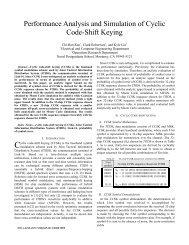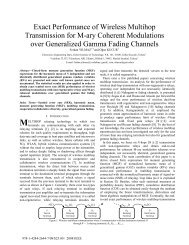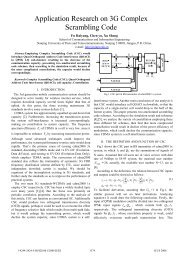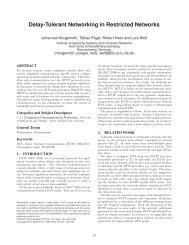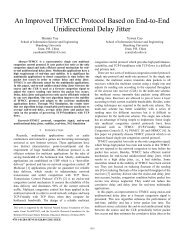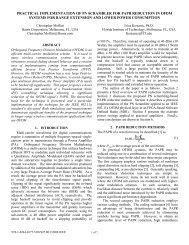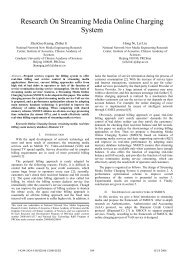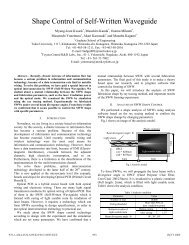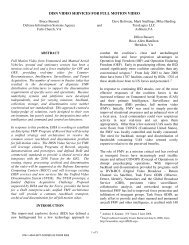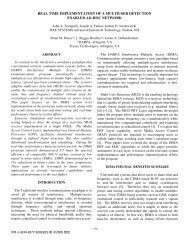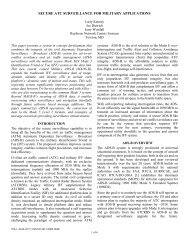Performance Analysis of a JTIDS/Link-16-type Waveform ...
Performance Analysis of a JTIDS/Link-16-type Waveform ...
Performance Analysis of a JTIDS/Link-16-type Waveform ...
Create successful ePaper yourself
Turn your PDF publications into a flip-book with our unique Google optimized e-Paper software.
⎛ 0.3125ra<br />
T ⎞<br />
pc ( a )<br />
.<br />
1 c = Q<br />
⎜ ⎟<br />
2<br />
c b'<br />
⎜ ⎟<br />
⎝<br />
N0 + NIρ1 ⎠<br />
2<br />
If γ = aT N , (<strong>16</strong>) can be rewritten as<br />
b c b'<br />
0<br />
( γ ) ( γ )<br />
c0b b<br />
(17)<br />
p = Q 0.3125 r ,<br />
(18)<br />
and the pdf in terms <strong>of</strong> γ b is given by<br />
m<br />
m−1<br />
γ ⎛ b m ⎞ ⎛−mγ ⎞ b<br />
fΓ<br />
( γ )<br />
exp , 0<br />
b b = ⎜ ⎟ ⎜ ⎟ γb<br />
≥ (19)<br />
Γ( m)<br />
⎜γ ⎟ ⎜<br />
b γ ⎟<br />
⎝ ⎠ ⎝ b ⎠<br />
2<br />
where γ b = aT c b'<br />
N0<br />
is defined as the ratio <strong>of</strong> the average<br />
energy per bit per pulse-to-noise power spectral density. If<br />
( )<br />
γT 2<br />
= aT c b' ⎡⎣N0 + NI<br />
ρ1<br />
⎤⎦<br />
, we can rewrite (17) as<br />
p γ = Q 0.3125 rγ<br />
,<br />
(20)<br />
( ) ( )<br />
c1T T<br />
and the pdf in terms <strong>of</strong> γ T is given by<br />
m<br />
m−1<br />
γ ⎛ T m ⎞ ⎛−mγ ⎞ T<br />
fΓ<br />
( γ )<br />
exp , 0<br />
T T = ⎜ ⎟ ⎜ ⎟ γT<br />
≥<br />
Γ( m)<br />
⎜γ ⎟ ⎜<br />
T γ ⎟<br />
⎝ ⎠ ⎝ T ⎠<br />
2<br />
where γ = aT N + ( N ρ )<br />
(21)<br />
T c b' ⎡⎣ 0 I 1 ⎤⎦<br />
. The average probability <strong>of</strong><br />
channel chip error when the PNI is <strong>of</strong>f is obtained from<br />
pc0 ∞<br />
= ∫ pc ( γ ) ( ) .<br />
0 b fΓγ b b dγ<br />
−∞<br />
b<br />
(22)<br />
Substituting (18) and (19) into (22), we obtain the average<br />
probability <strong>of</strong> channel chip error when the PNI is <strong>of</strong>f as<br />
m<br />
m−1<br />
∞ γ ⎛ b m ⎞ ⎛−mγ ⎞ b<br />
c = ( γ ) 0 0<br />
b ⎜ γb<br />
( m)<br />
⎜ ⎟<br />
γ ⎟ ⎜ ⎟<br />
b γ ⎟<br />
b<br />
p ∫ Q 0.3125r Γ ⎝ ⎠<br />
exp<br />
⎝<br />
d<br />
⎠<br />
. (23)<br />
When m is an integer, (23) can be evaluated to obtain [12]<br />
m m−1<br />
k<br />
⎛1− μ ⎞ ⎛m− 1+<br />
k⎞⎛1+<br />
μ ⎞<br />
pc<br />
=<br />
0 ⎜ ⎟ ∑ ⎜ ⎟<br />
2 k = 0 k<br />
⎜ ⎟<br />
⎝ ⎠ ⎝ ⎠⎝<br />
2 ⎠<br />
(24)<br />
μ = γ m + γ and γ0= 0.3125rγ 2 . Similarly,<br />
where 0 ( 0)<br />
the average probability <strong>of</strong> channel chip error when the PNI is<br />
on is given by<br />
m m−1<br />
k<br />
⎛1− ν ⎞ ⎛m− 1+<br />
k⎞⎛1+<br />
ν ⎞<br />
pc<br />
=<br />
1 ⎜ ⎟ ∑ ⎜ ⎟<br />
2 k = 0 k<br />
⎜ ⎟<br />
⎝ ⎠ ⎝ ⎠⎝<br />
2 ⎠<br />
(25)<br />
ν = γ m + γ and γ1= 0.3125rγ 2 . Using (24)<br />
where 1 ( 1)<br />
and (25) in (13) along with ζ UB from [9], we obtain<br />
j<br />
T<br />
b<br />
p s and<br />
0<br />
p s , respectively. Using p<br />
1<br />
s and p<br />
0<br />
s in (12), we obtain p<br />
1<br />
s .<br />
Using p s in (11), we obtain the probability <strong>of</strong> symbol error <strong>of</strong><br />
a <strong>JTIDS</strong>/<strong>Link</strong>-<strong>16</strong>-<strong>type</strong> waveform for the single-pulse structure<br />
in both AWGN and PNI when the signal is transmitted over a<br />
slow, flat Nakagami fading channel.<br />
For the double-pulse structure, it is difficult to investigate<br />
the performance for a <strong>JTIDS</strong>/<strong>Link</strong>-<strong>16</strong>-<strong>type</strong> waveform in both<br />
AWGN and PNI when the signal is transmitted over<br />
Nakagami fading channels since it is extremely complex to<br />
obtain an analytic expression for the average probability <strong>of</strong><br />
channel chip error given that one pulse is jammed. Instead, the<br />
performance for a <strong>JTIDS</strong>/<strong>Link</strong>-<strong>16</strong>-<strong>type</strong> waveform in both<br />
AWGN and BNI transmitted over a slow, flat Nakagami<br />
fading channel is evaluated. In this case, we assume maximalratio<br />
detection with linear combining. For maximal-ratio<br />
detection with linear combining when both AWGN and BNI<br />
are present, the conditional probability <strong>of</strong> channel chip error<br />
given that both pulses are affected by BNI is<br />
⎛ 2 2<br />
0.3125r(<br />
ac + ac ) T ⎞<br />
b'<br />
pc( ac) = Q⎜<br />
⎟.<br />
(26)<br />
⎜ N0+ N ⎟<br />
I<br />
⎝ ⎠<br />
We can rewrite (26) as<br />
p γ = Q 0.3125r<br />
γ + γ<br />
(27)<br />
( )<br />
c( T ) ( T T )<br />
since<br />
2<br />
aT ( N N ) γ γ γ<br />
γ T = c b' 0 + I . If T T T<br />
∗ ∗<br />
( γ ) ( γ )<br />
∗ = + , (27) becomes<br />
p = Q 0.3125 r ,<br />
(28)<br />
c T T<br />
and the pdf in terms <strong>of</strong> γ T<br />
∗ is given by<br />
f<br />
( )<br />
( )<br />
∗<br />
2m−1 2m<br />
γ ∗<br />
T ⎛ m ⎞ ⎛ ∗ −mγ<br />
⎞ T ∗<br />
T ⎜ ⎟ T<br />
γ ⎟ ⎜ ⎟<br />
T γ ⎟<br />
T<br />
γ = exp , γ ≥0<br />
Γ ⎝ ⎠ ⎝ ⎠<br />
∗<br />
ΓT<br />
( 2m)<br />
where<br />
2<br />
aT ( N N )<br />
(29)<br />
γ T = c b' 0 + I .<br />
The average probability <strong>of</strong> channel chip error given that<br />
both pulses are affected by BNI is<br />
∞<br />
∗ ∗ ∗<br />
pc = pc ( γT ) f ∗ ∫ ( γT ) dγT.<br />
−∞<br />
ΓT<br />
Substituting (28) and (29) into (30), we obtain<br />
(30)<br />
( )<br />
∗<br />
2m−1 2m<br />
γ ∗<br />
∞<br />
T ⎛m⎞ ⎛ ∗ −mγ<br />
⎞ T ∗<br />
c = ( γ ) 0<br />
T ⎜ γT<br />
( 2m)<br />
⎜ ⎟<br />
γ ⎟ ⎜ ⎟<br />
T γ ⎟<br />
T<br />
p ∫ Q 0.3125r Γ ⎝ ⎠<br />
exp<br />
⎝<br />
d<br />
⎠<br />
. (31)<br />
When m is an integer, (31) can be evaluated to obtain<br />
2m 2m−1 k<br />
⎛1− β ⎞ ⎛2m− 1+<br />
k⎞⎛1+<br />
β ⎞<br />
pc<br />
= ⎜ ⎟ ∑ ⎜ ⎟<br />
2 k = 0 k<br />
⎜ ⎟<br />
⎝ ⎠ ⎝ ⎠⎝<br />
2 ⎠<br />
(32)<br />
β γ 2m γ γ = rγ<br />
. Using (32) in<br />
= + and 2 0.3125 T<br />
where 2 ( 2)<br />
(9) along with ζ UB from [9], we obtain<br />
j<br />
s p . Next, using p s in<br />
(11), we obtain the probability <strong>of</strong> symbol error <strong>of</strong> a<br />
<strong>JTIDS</strong>/<strong>Link</strong>-<strong>16</strong>-<strong>type</strong> waveform for the double-pulse structure<br />
in both AWGN and BNI when the signal is transmitted over a<br />
slow, flat Nakagami fading channel.<br />
IV. NUMERICAL RESULTS<br />
The probabilities <strong>of</strong> symbol error <strong>of</strong> a <strong>JTIDS</strong>/<strong>Link</strong>-<strong>16</strong>-<strong>type</strong><br />
waveform for both the single- and the double-pulse structure<br />
in AWGN are shown in Figure 4. As expected, the doublepulse<br />
structure outperforms the single-pulse structure in terms<br />
<strong>of</strong> average energy per bit per pulse b '<br />
b ' 0<br />
while the b ' 0<br />
E . At<br />
P<br />
−5<br />
S = 10 , the<br />
E N required for the double-pulse structure is about 4 dB,<br />
E N required for the single-pulse structure is<br />
about 7.1 dB. In other words, the double-pulse structure<br />
−5<br />
outperforms the single-pulse structure by 3.1 dB at PS<br />
= 10<br />
in AWGN.



